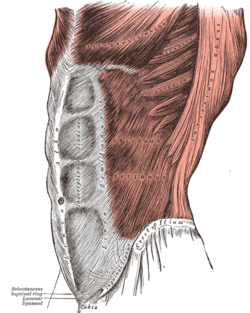Linea alba (abdomen)
| Linea alba | |
|---|---|
 Diagram of the rectus sheath. | |
 | |
| Details | |
| Identifiers | |
| Latin | linea alba |
| TA98 | A04.5.01.022 |
| TA2 | 2377 |
| FMA | 11336 |
| Anatomical terminology | |
The linea alba (Latin for: white line) is a strong fibrous midline structure[1] of the anterior abdominal wall[2] situated between the two recti abdominis muscles (one on either side). The umbilicus (navel) is a defect in the linea alba through which foetal umbilical vessels pass before birth.[1] The linea alba is formed by the union of aponeuroses (of the muscles of the anterior abdominal wall[2]) that collectively make up the rectus sheath. The linea alba attaches to the xiphoid process superiorly, and to the pubic symphysis inferiorly. It is narrow inferiorly where the two recti abdominis muscles are in contact with each other posterior to it, and broadens superior-ward from just inferior to the umbilicus.[1]
The name means white line as it is composed mostly of collagen connective tissue, which has a white appearance.[citation needed]
In sufficiently muscular individuals, its presence can be seen on the skin, forming the depression between the left and right halves of a "six pack".[citation needed]
Function
The linea alba stabilizes the anterior abdominal wall, as it balances contractile forces from the muscles attached to it.[2]
Clinical significance
An abnormal widening of the linea alba is known as diastasis recti.
During pregnancy, the linea alba usually darkens due to hormonal changes whereupon it becomes known as the linea nigra. The linea nigra sometimes also occurs in either sex outside the context of pregnancy.
A median incision through the linea alba is a common surgical approach for abdominal surgery. This is because it consists of mostly connective tissue, and does not contain any primary nerves or blood vessels.[citation needed]
Additional images
-
Surface anatomy of the front of the thorax and abdomen.
-
Linea alba
See also
References
- ^ a b c Sinnatamby, Chummy (2011). Last's Anatomy (12th ed.). Elsevier Australia. p. 224. ISBN 978-0-7295-3752-0.
- ^ a b c Gräβel, David; Prescher, Andreas; Fitzek, Sabine; Keyserlingk, Diedrich Graf v.; Axer, Hubertus (2005-03-01). "Anisotropy of human linea alba: A biomechanical study". Journal of Surgical Research. 124 (1): 118–125. doi:10.1016/j.jss.2004.10.010. ISSN 0022-4804. PMID 15734489.
External links
- skel&wallsabd at The Anatomy Lesson by Wesley Norman (Georgetown University)
- Anatomy photo:35:os-0108 at the SUNY Downstate Medical Center (before removing skin)
- Anatomy photo:35:06-0101 at the SUNY Downstate Medical Center (after removing skin)
- "Anatomy diagram: 03281.000-2". Roche Lexicon - illustrated navigator. Elsevier. Archived from the original on 2014-01-01.

